Physics 15 Torque (14 of 27) Body Mechanics: Ex. 2, F=? To Lift Dumbbell
TLDRThis video script delves into the physics of muscle strength, specifically examining the force required in the forearm muscles to hold up a 20-pound barbell. The analysis uses the concept of torque, considering the pivot point at the elbow, the weight's distance from the pivot, and the angle of the muscle's force. By calculating the torque created by the barbell's weight and the counteracting torque needed by the forearm muscle, the script reveals that an astonishing 242 pounds of force is required to hold the barbell aloft. This illustrates the incredible strength of human muscles and provides a fascinating application of physics to understanding the human body.
Takeaways
- 🏋️♂️ The video discusses the strength required in the forearm muscles to hold up a 20-pound barbell statically.
- 📐 It is important to consider the leverage and the pivot point of the elbow joint when calculating the force exerted by the forearm muscles.
- 🤔 The weight of the forearm itself is ignored for simplicity, though it contributes to the overall force required.
- 📏 The distance from the tendon attachment on the humerus to the elbow joint is approximately 8 cm.
- 📏 The distance from the elbow joint to the middle of the palm, where the weight is held, is about 25 cm.
- 🔵 The tendon and muscle structure form an angle of 75° with the humerus, which translates to a 15° angle with the horizontal.
- 🔄 The sum of all torques about the pivot point must equal zero, considering the downward force of the weight and the upward force of the muscle.
- ⚖️ The force exerted by the muscle creates a counterclockwise torque, which is balanced by the clockwise torque from the weight's force.
- 📐 The perpendicular distance (D) from the line of action of the muscle force to the pivot point is calculated using trigonometry.
- 🧮 The force required by the muscle is calculated by balancing the torques and using the formula involving the weight in Newtons, distances in cm, and the sine of the angle.
- 🎓 The final calculation reveals that the muscle in the forearm must exert a force equivalent to 242 pounds to hold up a 20-pound barbell in the described position.
Q & A
What is the primary focus of the discussion in the provided transcript?
-The primary focus is to determine the strength required of the forearm muscles to hold up a 20-pound barbell, using the principles of physics and torque.
What is the approximate distance from the tendon attachment to the elbow joint?
-The distance from the tendon attachment to the elbow joint is about 8 cm.
How far is the elbow joint from the middle of the palm where the weight is held?
-The elbow joint is about 25 cm away from the middle of the palm.
Why is the weight of the forearm itself ignored in the calculation?
-The weight of the forearm is ignored because it is not the biggest contributing part to the force required in the tendon.
What is the angle formed by the tendon and muscle structure relative to the vertical?
-The tendon and muscle structure form an angle of 75° to the vertical, which is a 15° angle with the horizontal.
What is the relationship between the force exerted by the muscle and the torque about the pivot point?
-The force exerted by the muscle creates a counterclockwise torque about the pivot point, which is necessary to balance the clockwise torque caused by the weight of the barbell.
What is the formula used to calculate the force required by the muscle?
-The formula used is the sum of the torques about the pivot point (point A) must equal zero: -mg * 25 cm + (force exerted by muscle) * D = 0, where D is the perpendicular distance from the line of action of the force to the pivot point.
What is the conversion factor used to convert Newtons to pounds?
-The conversion factor used is 1 pound is equal to 4.448 Newtons.
What is the final calculated force required by the forearm muscle to hold up a 20-pound barbell?
-The final calculated force required by the forearm muscle is approximately 242 pounds.
How does the angle of the muscle relative to the horizontal affect the force required?
-The angle affects the force required because it determines the perpendicular distance (D) from the line of action of the force to the pivot point, which is used in the torque calculation.
What is the significance of using the law of physics and the concept of torque in this scenario?
-Using the law of physics and the concept of torque allows for a precise calculation of the muscle force required, demonstrating the remarkable strength of human muscles in everyday activities.
What is the role of the pivot point in the analysis of the muscle force?
-The pivot point (point A) is the center around which torques are calculated. It is the point about which the sum of all torques must equal zero for the arm to hold the barbell in a stationary position.
Outlines
🏋️♂️ Calculating Forearm Muscle Force for Holding a Barbell
This paragraph explains the physics behind determining the strength required in the forearm muscles to hold up a barbell. The speaker uses a 20-pound barbell as an example and identifies the muscle involved as being connected to the humerus and extending past the elbow joint. The tendon's attachment point to the humerus is 8 cm from the elbow, and the barbell's weight is held 25 cm from the pivot point. By ignoring the forearm's weight for simplicity, the speaker calculates the force needed by considering the torque around the elbow joint. The force exerted by the muscle forms an angle of 75° with the vertical, resulting in a 15° angle with the horizontal. Using the torque equation, the force required by the muscle is calculated to be significantly higher than the barbell's weight due to the leverage effect, emphasizing the strength of the forearm muscles.
🧮 Converting Newtons to Pounds: The Actual Force in Your Forearm
The second paragraph focuses on converting the force required by the forearm muscles, which was calculated in Newtons, into a more familiar unit of measurement, pounds. It is revealed that the muscle in the forearm must exert a force of 242 pounds to hold up the 20-pound barbell in the described scenario. This conversion is done by dividing the force in Newtons by 4.44, as one pound is equivalent to 4448 Newtons. The speaker marvels at the strength of the human body, noting that even small weights require a significant amount of force to be held up, showcasing the remarkable power of our muscles and the application of physics and torque in real-life scenarios.
Mindmap
Keywords
💡Muscle Strength
💡Barbell
💡Humerus
💡Pivot Point
💡Torque
💡Tendons
💡Angles
💡Newtons
💡Distance
💡Physics
💡Biomechanics
Highlights
The discussion aims to determine the strength required of the forearm muscles to hold up a 20-pound barbell.
The muscle in question is attached to the humerus and extends past the elbow joint, connected to the hand via tendons.
The force exerted by the forearm muscles is calculated based on the pivot point of the elbow joint.
The tendon's attachment point is approximately 8 cm from the elbow joint, and the weight is held 25 cm from the pivot.
Ignoring the weight of the forearm itself for simplicity, though it contributes to the force required.
The tendon and muscle structure form a 75° angle with the humerus and a 15° angle with the horizontal.
A graphical representation is used to visualize the forces and torques involved.
The sum of all torques about the pivot point must equal zero, leading to a balance of forces.
The force of gravity (mg) acting on the 20-pound weight creates a torque relative to the pivot point.
The muscle force creates a counteracting torque to hold the weight up against gravity.
The perpendicular distance (D) from the line of action of the muscle force to the pivot point is crucial for the calculation.
The angle θ is used to calculate the hypotenuse (D), which is the distance from the pivot to the muscle's attachment.
The force exerted by the muscle is found by balancing the torques and using trigonometric functions.
The calculation reveals that the muscle force required is 242 pounds, significantly higher than the actual weight of the barbell.
This demonstrates the remarkable strength of the human body's muscles, even for holding relatively small weights.
The laws of physics and the concept of torque are applied to understand and calculate the muscle force required.
The process highlights the complexity of muscle strength and the underlying physics involved in simple tasks.
The conversion from Newtons to pounds provides a relatable measure of the force in a common unit of measure.
Transcripts
Browse More Related Video
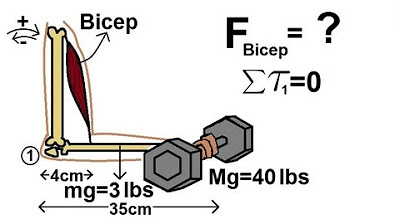
Physics 15 Torque Example 5 (5 of 7) The Bicep
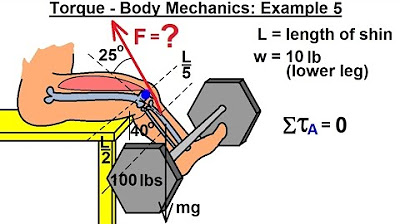
Physics 15 Torque (17 of 25) Body Mechanics: Ex. 5, F=? Leg Lifting Weights

Physics 15 Torque (13 of 27) Body Mechanics: Ex. 1, F=? To Lift Up Arm
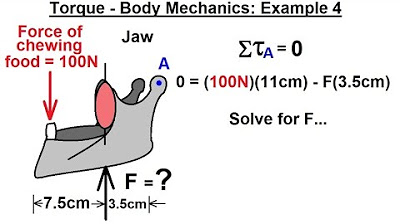
Physics 15 Torque (16 of 25) Body Mechanics: Ex. 4, F=? Jaw Muscle
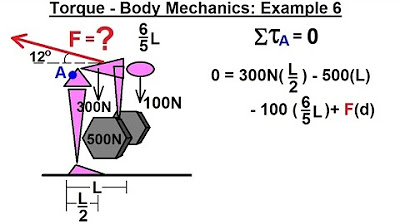
Physics 15 Torque (18 of 25) Body Mechanics: Ex. 6, F=? on Back Muscle
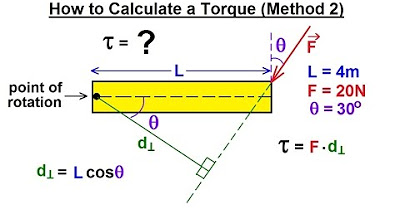
Physics 15 Torque Fundamentals (5 of 13) How to Calculate a Torque (Method 2)
5.0 / 5 (0 votes)
Thanks for rating: